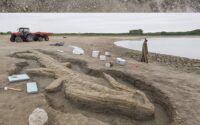The Buried Wonder: Uncovering the Temple of Artemis and Its Hidden Secrets .bongbenh
Imagine standing in a swampy field in modern-day Turkey, where a single, lonely column rises from the ground, crowned by a stork’s nest. This unassuming scene is all that remains of the Temple of Artemis at Ephesus, one of the Seven Wonders of the Ancient World. But rewind to 1869, when British archaeologist John Turtle Wood unearthed a staggering sight: massive marble pillars, buried deep beneath layers of earth, some submerged up to 20 feet underground. The discovery shocked the world—how could such colossal structures, once towering 60 feet high, vanish so completely? And what secrets were they hiding beneath the soil for centuries? This is the story of the Temple of Artemis, a marvel that continues to baffle and intrigue, leaving us to wonder: was it simply lost to time, or is there a darker mystery at play?
The Temple of Artemis, also known as the Artemision, was a masterpiece of ancient architecture. Built around 550 BC under the patronage of King Croesus of Lydia, it was designed by the architect Chersiphron and his son Metagenes. Measuring approximately 377 feet long and 151 feet wide, with 127 Ionic columns standing 60 feet tall, it dwarfed even the Parthenon in Athens. Its marble façade gleamed under the Anatolian sun, adorned with intricate sculptures and offerings of gold, silver, and precious gems. Pilgrims, merchants, and kings flocked to Ephesus to worship Artemis, the goddess of the hunt, fertility, and childbirth, whose cult brought immense wealth to the city. Yet, by the 5th century AD, this grand temple had all but disappeared, its stones repurposed, its foundations swallowed by the earth. How could something so magnificent be reduced to a single reconstructed column?
The rediscovery of the temple in 1869 was nothing short of a detective story. For six years, John Turtle Wood, funded by the British Museum, scoured the marshy outskirts of Ephesus, guided by ancient texts and inscriptions. On December 31, 1869, he struck gold—or rather, marble. Beneath 20 feet of sediment, he found the temple’s foundations, along with massive column drums, some so large they defied belief. One pillar, now iconic in photographs shared across social media, was almost entirely buried, with only its top barely peeking above the ground before excavation. The images are haunting: a colossal structure, once a symbol of divine power, entombed in silence. But why was it buried so deeply? Was it merely the work of floods and time, or did someone—or something—want it hidden?
The temple’s history is riddled with destruction and rebirth. In the 7th century BC, a flood devastated an earlier version of the temple, depositing over 1.6 feet of sand and debris. The Ephesians rebuilt, raising the foundation by 6.5 feet. Then, in 356 BC, the temple was infamously burned down by Herostratus, an arsonist seeking eternal fame. Legend has it that Artemis was absent that night, aiding the birth of Alexander the Great. Rebuilt yet again, the temple stood until the Goths sacked it in 262 AD, followed by earthquakes and the rise of Christianity, which led to its final dismantling in 401 AD. Its stones were quarried for churches, including the Hagia Sophia, leaving the site to sink into the swamp. But the sheer depth of the burial—20 feet of earth covering massive pillars—raises questions. Could natural processes alone account for this, or was the temple deliberately erased from history?
Excavations revealed more than just columns. Archaeologists uncovered votive offerings—gold, silver, ivory, and amber artifacts—buried in the foundations, including a cache of coins from 600 BC, possibly the oldest in the world. These treasures hint at the temple’s role as a sanctuary, where devotees left gifts for Artemis. Yet, some findings are unsettling. The statue of Artemis Ephesia, unlike the Greek goddess of the hunt, resembled Near-Eastern deities, with a pillar-like body and multiple oval objects on her chest, once thought to be breasts but now believed to be amber gourds or ritual symbols. Was this Artemis a fusion of cultures, or evidence of a forgotten cult? And why were some artifacts, like an ivory griffin and Assyrian-style Tree of Life, found in flood debris, suggesting connections to distant civilizations?

Recent posts on X have reignited fascination with the temple’s buried state. Images of a massive pillar, half-unearthed, have sparked speculation online. Some users marvel at the depth of the burial, with one noting, “Large amounts of soil were removed… at least 10 meters deep. ‘Cultural layers,’ archaeologists say.” Others question how entire cities, like Ephesus, could be swallowed by the earth. These posts tap into a growing curiosity: are we underestimating the forces—natural or otherwise—that buried these wonders? Could the temple’s disappearance be linked to more than floods and earthquakes? Some even whisper of a deliberate cover-up, though no evidence supports this. The mystery deepens when we consider that the temple’s site, now a UNESCO World Heritage Site, remains a swamp, with groundwater hampering further digs. What else lies beneath, waiting to be uncovered?
The temple’s story is also one of cultural collision. Before the Greeks, the site was a sanctuary for Cybele, an Anatolian mother goddess. The Ephesians blended her with Artemis, creating a unique deity worshipped by Ionians, Lydians, and even Amazons, according to legend. The temple’s westward orientation, unusual for Greek temples, aligns with other Anatolian sanctuaries, hinting at its pre-Greek roots. Excavations in 1987–1988 confirmed Bronze Age occupation, with pottery dating back to the Middle Geometric period. Could the temple’s burial reflect a clash of civilizations, where later powers sought to erase its pagan past? The Christian mob that tore it down in 401 AD certainly had motive, but the depth of the sediment suggests centuries of neglect—or something more sinister.
🌟 Pause and ponder: If you stood before that buried pillar, half-exposed after millennia, what would you feel? Awe at its grandeur, or unease at its concealment? What if the temple’s burial wasn’t an accident, but a deliberate act to hide its power? And if we dug deeper, what truths might we uncover—about Artemis, Ephesus, or even ourselves? Have you ever felt that history is hiding something just out of reach, buried beneath layers we’re too afraid to disturb?
The Temple of Artemis remains a paradox: a wonder lost, found, and still elusive. Its single standing column, reconstructed in 1972, is a poignant reminder of what was and what might still be hidden. As archaeologists battle rising groundwater and limited funds, the site holds its secrets close. Is it just a victim of time, or does it guard a story we’re not ready to hear? Share your thoughts, spread this enigma, and join the quest to unravel the truth. But beware: once you start digging, you may find more questions than answers, and the shadows of Ephesus might never let you go. 🌿❓
#TempleOfArtemis #BuriedWonder #EphesusMystery


